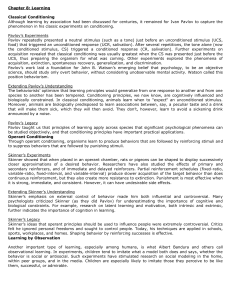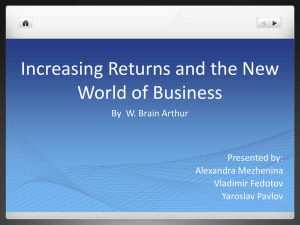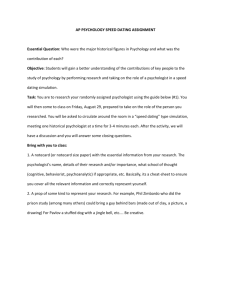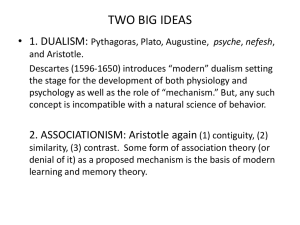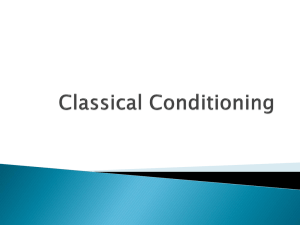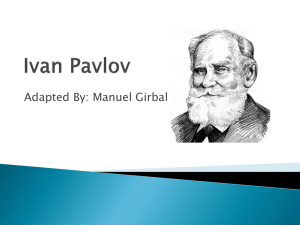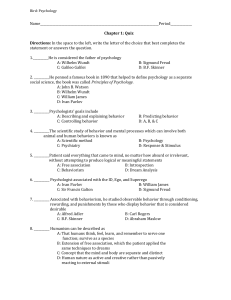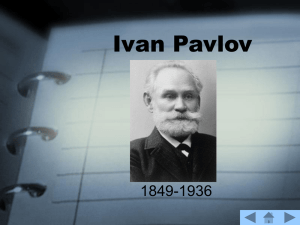Integrative Physiological & Behavioral Science, April
advertisement
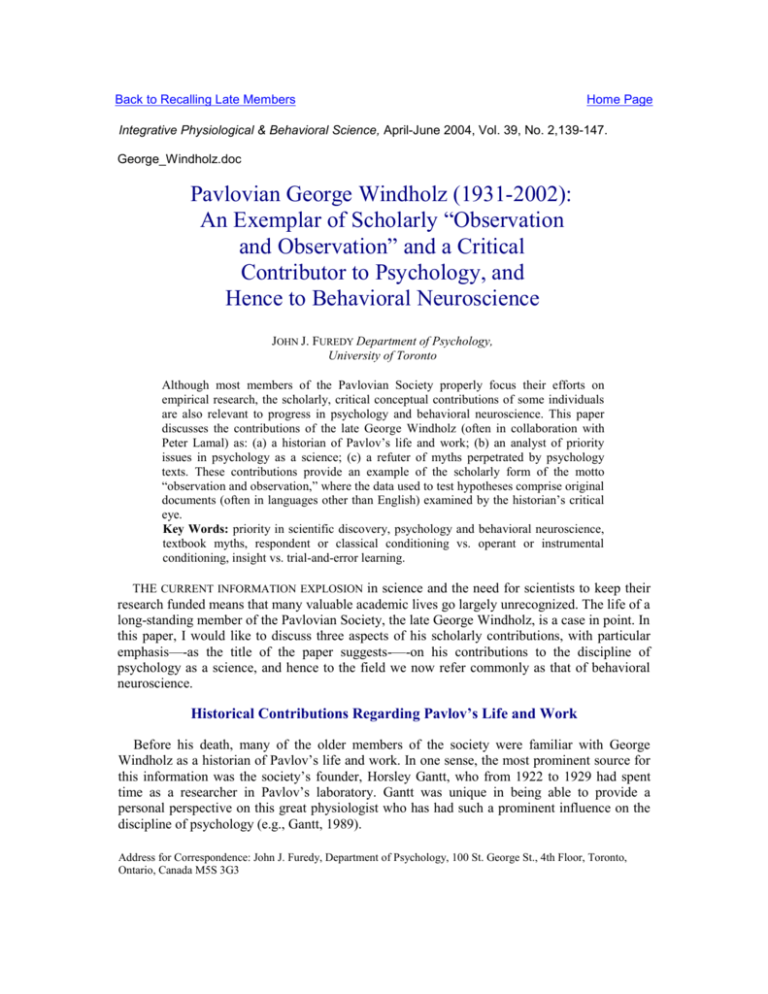
Back to Recalling Late Members Home Page Integrative Physiological & Behavioral Science, April-June 2004, Vol. 39, No. 2,139-147. George_Windholz.doc Pavlovian George Windholz (1931-2002): An Exemplar of Scholarly “Observation and Observation” and a Critical Contributor to Psychology, and Hence to Behavioral Neuroscience JOHN J. FUREDY Department of Psychology, University of Toronto Although most members of the Pavlovian Society properly focus their efforts on empirical research, the scholarly, critical conceptual contributions of some individuals are also relevant to progress in psychology and behavioral neuroscience. This paper discusses the contributions of the late George Windholz (often in collaboration with Peter Lamal) as: (a) a historian of Pavlov’s life and work; (b) an analyst of priority issues in psychology as a science; (c) a refuter of myths perpetrated by psychology texts. These contributions provide an example of the scholarly form of the motto “observation and observation,” where the data used to test hypotheses comprise original documents (often in languages other than English) examined by the historian’s critical eye. Key Words: priority in scientific discovery, psychology and behavioral neuroscience, textbook myths, respondent or classical conditioning vs. operant or instrumental conditioning, insight vs. trial-and-error learning. THE CURRENT INFORMATION EXPLOSION in science and the need for scientists to keep their research funded means that many valuable academic lives go largely unrecognized. The life of a long-standing member of the Pavlovian Society, the late George Windholz, is a case in point. In this paper, I would like to discuss three aspects of his scholarly contributions, with particular emphasis—-as the title of the paper suggests-—-on his contributions to the discipline of psychology as a science, and hence to the field we now refer commonly as that of behavioral neuroscience. Historical Contributions Regarding Pavlov’s Life and Work Before his death, many of the older members of the society were familiar with George Windholz as a historian of Pavlov’s life and work. In one sense, the most prominent source for this information was the society’s founder, Horsley Gantt, who from 1922 to 1929 had spent time as a researcher in Pavlov’s laboratory. Gantt was unique in being able to provide a personal perspective on this great physiologist who has had such a prominent influence on the discipline of psychology (e.g., Gantt, 1989). Address for Correspondence: John J. Furedy, Department of Psychology, 100 St. George St., 4th Floor, Toronto, Ontario, Canada M5S 3G3 140 FUREDY Still, in terms of historical scholarship, it is arguable that Windholz constitutes a more valuable source, even though he never worked with, or even met, Pavlov. Most historical work, after all, relies not on personal experience but on extensive reading of and thinking about the topic of interest. The products of Windholz’s reading and thinking are in some 40 published papers about Pavlov, beginning with Windholz (1983) and ending with Grimsley and Windholz (2000). Among these papers are those dealing with purely historical issues both at a general level (e.g. Windholz, 1997), as well as such particulars as Pavlov’s youth (e.g., Windholz, 1991) and the positive as well as negative influence of his father on his intellectual development (Furedy, 2003b). In addition, there are papers grounded in expertise in the discipline of psychology. That expertise includes a conceptual understanding of the major issues that have pre-occupied the experimental aspects of that discipline. For example, Windholz and Lamal (1986a) related Pavlov’s work to the concept of association, which has continued to be a central principle in learning theory. Again, Windholz and Wyrwicka’s (1996) article on “Pavlov’s position toward Konorski and Miller’s distinction between Pavlovian and motor conditioning paradigms” is relevant to what used to be considered as the instrumental conditioning of autonomic responses (e.g., Miller, 1969) but is more recently referred to as biofeedback. And, more generally, Windholz (1987) provided a paper in which he went beyond Pavlov’s work on “conditional reflexes” (with which American psychologists were most familiar), and discussed Pavlov’s work on “higher nervous activity encompassing overt behavior, neural processes, and conscious experiences” (Windholz, 1987: 103). These concepts, he suggested, were all of interest to “contemporary psychology,” and, one might add, also to behavioral neuroscience. I would also contend that Pavlov’s approach espoused a methodological brand of behaviorism, in opposition to a metaphysical brand that was explicitly espoused by Watson and Skinner, and implicitly supported by the Hull-Spence anti-cognitive, S-R school (Furedy, 2003c). Moreover, a feature of methodological behaviorism, in contrast to its metaphysical competitor, is that it does not seek to rule any class of phenomena out of consideration, but rather, in the spirit of the preSocratic “Greek way of thinking about the world,” takes the task of “saving the appearances” seriously (Furedy, 2001), and hence recognizes psychological functions such as cognition as genuine phenomena that need to be explained, rather than as epiphenomena that can be dismissed as somehow unreal. Priority Issues in Psychology as Science For most members of the society, who are active experimental researchers, the motto “observation and observation” refers to the data gathered from various experimental preparations. However, scholarly investigations revealing details that are relevant for, and often contrary to, views held by most experts in the discipline, can also be viewed as hewing to the motto. Much of current experimental psychology, indeed, largely shows an absence of this sort of “strong inference” (Platt, 1964), where observations not only confirm but also disconfirm popular theories. In this section I discuss four papers in which Windholz was either first or sole author, papers that deal with priority issues in psychology as a science. All four illustrate the way in which a scholar can test hypotheses without running experiments, and so contribute (sometimes in a corrective way) to progress in the discipline. The first paper entitled “Priority in the classical conditioning of children” (Windholz & Lamal, 1986b) argues for the claim that, “contrary to widely held belief,” Watson and Rainer’s account (1920), they were not the first to report this phenomenon. Rather, GEORGE WINHOLZ (1931-2002) 141 Windholz and Lamal provide evidence of two reports that predated the Watson/Rainer report by almost 15 years, and one that either preceded or coincided with the Little-Albert report. Specifically, in terms of actual priority, they identify German (Heinrich Bogan) and Russian (Nikolai Krasnogorskii) researchers as being authors of separate and independent reports of child classical conditioning in 1907. Of more interest than this strictly legalistic claim regarding priority is the discussion and details that they provide regarding the work of the Russian researcher and the later work of an American, Florence Mateer. They cite four reports by Krasnogorskii during 1907-1908 in which he provided methodological or rather technical criticisms of Bogan’s use of a stomach fistula for his (unfortunate) child subject, considered methodological shortcomings of his own experiments, and (in line with Pavlov’s own experimental methods, with which he was familiar) began a program to investigate such phenomena as extinction, generalization, differentiation, and trace conditioning. This shows that Krasnogosrkii’s work not only predated the Watson/Rainer work, hut was also superior to it in terms of the range of conditioning phenomena studied. My own interpretation of J.B. Watson was that he was essentially an ideologue with metaphysical behaviorism as his particular quasi religion (e.g., Watson, 1913). For him the conditional response (CR) functioned as a basic explanatory unit of all behavior (in much the same way as the atom did for Democritus) and a cudgel with which to beat “mentalists” like Wundt. In contrast, Krasnogorskii, following Pavlov, took a methodological behaviorist approach (for the difference between methodological and metaphysical behaviorism, see Furedy, 2001), and treated the CR as a phenomenon to be systemically investigated in a variety of preparations and organisms. It may seem unfair to accuse Watson of treating conditioning in children in an ideological rather than scholarly way solely on the basis of his ignoring the prior work of Krasnogoskii. After all, the language barrier was considerable, especially in those early days. But as Windholz and Lamal’s (1986b) extensive scholarly treatment details, no such excuse is available for Watson when it comes to his ignoring the work of fellow American Florence Mateer, whose name is virtually unknown both to developmental and learning psychologists. This work included systematic investigations and discussion of child classical conditioning. Moreover, she not only “presented her work cautiously” (Windholz and Lamal, 1986: 194) in her book (Mateer, 1918), but also showed considerable and quite modem sensitivity to the need for statistical reliability when she wrote that “the number of cases in this study is far too small to give results that can be accepted as absolute and final and I desire to make no dogmatic assertion of the manner of functioning of conditioned reflexes in children” (p. 188). Windholz and Lamal (1986b) contrast this cautious treatment by Mateer of child classical conditioning with that of Watson (“at least as he is presented in contemporary texts”), but I would add that especially with respect to the need for statistical reliability for classical conditioning phenomena in general, Mateer stands favorably compared even to Pavlov. Pavlov’s laboratory did provide a systematic experimental treatment as well as a conceptual framework or “paradigm” for classical conditioning, but the dog salivary preparation it employed for those investigations did not provide data of sufficient reliability to permit statistical inference or ready replication across different laboratories. Still, aside from the issue of statistical reliability (essential for replications of phenomena), there are important differences among conceptual treatment of a phenomenon and the merely “naturalistic” observing of a phenomenon (always the initial step in any scientific discovery), its systematic experimental investigation, and whether it is put in a conceptual context that is new and, in the end, accepted by the scientific community. It is these 142 FUREDY differences that Windholz (1986) discusses in his “Comparative analysis of the conditional reflex discoveries of Pavlov and Twitmeyer, and the birth of a paradigm,” a paper which is arguably his most sophisticated contribution to the issue of priority regarding the discovery of the phenomenon of classical conditioning. On the question of initial “naturalistic” observation, this historian used “primary sources, whenever possible” (Windholz, 1986: 141), and concluded that at least the students of Pavlov preceded Twitmeyer by a few years, but that because of the geographical distance between Pavlov’s lab and the University of Pennsylvania (where Twitmeyer conduced his dissertation), the two discoveries were completely independent and close enough in time to be considered essentially simultaneous. The reason for this “coincidence,” he suggests, is the current “Zeitgeist to investigate the organism’s reflexive behavior in the laboratory” (Windholz, 1986: 144). As to systematic experimental investigation, not only Pavlov but also Twitmeyer satisfied this second criterion of discovery in an experimental science, inasmuch as both “interrupted the line of their current research and proceeded to investigate systematically the CR” (Windholz, 1986: 144), with the latter literally interrupting his dissertation experiments on the variability of patellar responses. It is rather, in the provision of a “paradigm” in Windholz’s terms meant in the sense introduced by Kuhn (1962) that Pavlov differed from Twitmeyer. The latter is stated to have provided “no extensive explanation” for the CR phenomenon. This is hardly surprising given his relatively junior and relatively low status as a scientist. In addition, Twitmeyer’s only publication of his research, though in a prominent journal (Twitmeyer, 1905), was essentially no more than a brief summary of his findings. In contrast, Pavlov did provide a recognizably new conceptual context for classical conditioning. At the surface level this is obvious if only because the preparation bears his name as a synonym for “classical.” As well, the adjective “Pavlovian” is meaningful (though with different connotations) even for the educated laiety (see, e.g., Furedy, 2003b). However, a much deeper analysis of what he calls Pavlov’s paradigmatic contribution is provided by Windholz (1986). He notes the difference between the Cartesian conceptualization of the reflex (wherein only stimuli acting directly on the receptors elicit the reflex), and the Pavlovian at-a-distance action that necessarily introduces the organisms interaction with the environment through higher nervous activity. As well (and this is another contrast with Twitmeyer), he argues (by citing a 1923 lecture by Pavlov) that the attention to the role of higher nervous activity was due to Pavlov’s being influenced, early in his career, by the writings of Pisarev (a popularizer of Darwin) and Sechenov (“the father of Russian physiology” who stressed the importance of the central nervous system). More interesting, still, is an example of Pavlov defending his paradigm against, and differentiating it from, the paradigm of “contemporary associationistic psychology.” In a section entitled “Pavlov confronts Snarskii,” Windholz (1986: 145), we read about Pavlov’s acceptance of Snarskii’s dissertation data, but his rejection of an interpretation Pavlov dismissed both because it was “anthropomorphic” and paid insufficient attention to the central nervous system. As regards the latter aspect, Windholz cites the following 1902 instructions of Pavlov to his “disciples” concerning his paradigm: “Down with the physiology of digestion. I will train all of you to study the nervous system.” I cannot help noting that Pavlov’s tone is consistent with current North American academic mores, wherein even post-doctoral students are talked of as being “trained” rather than educated (see Furedy, 1992; 2003a), and are indeed more like disciples who must hew to their master’s GEORGE WINHOLZ (1931-2002) 143 voice or paradigm, rather than like students of a discipline. Be that as it may, there is no question that, in terms of establishing a paradigm, Pavlov was very different from Twitmeyer. Another contribution that a historian of science can provide is to refute “text book” accounts of discoveries, accounts that impose a false orderliness on how those discoveries were actually made. In the natural sciences it was probably Kuhn (1962) who first provided this sort of analysis to refute “text-book” accounts of revolutions like the Copernican one that suggested a very orderly and logical sequence of events. In Windholz (1989) we find the same sort of historical analysis of the “discovery of the principles of reinforcement, extinction, generalization, and differentiation of conditional reflexes in Pavlov’s laboratories.” In this paper, Windholz suggests that psychological text book accounts of classical conditioning and of the four basic phenomena mentioned in the title of the paper, are based on Pavlov’s Conditioned Reflexes as translated by Anrep in 1927. Pavlov summarized a quarter century of experimentation, and did not give an accurate “chronological, or historical course of events” (Windholz, 1989: 35), especially as regards the first decade of the research, much of which was conducted by Pavlov’s “disciples” who were “under his close supervision.” The bulk of Windholz’s (1989) paper (pp. 356-341) is devoted to showing the “actual process of discovery in Pavlov’s laboratory” (p. 35), a process that included periods where the pursuit of the underlying principles was “chaotic” and experiments were “inadequately designed,” even though, eventually, the work did yield “the secrets of the conditional reflex paradigm.” In his historian mode, Windholz contrasts Pavlov’s (1927) lectures that presented “the already refined findings in terms of well established principles” based on “well-controlled procedures that were used by Pavlov in the 1920s” with dissertations like that of Kashereninova (1908)-—-a “mass of chaotic findings gotten from badly designed and poorly controlled experiments” (Windholz, 1986: 41). Even the dissertation of Boldyrev (1905), which is described by Windholz as “an orderly systematic presentation of results obtained through welldesigned experiments” was based on a procedure where the experimenter faced the (dog) subject, and presented stimuli which were stored under the table, in contrast to “Pavlov’s strictly controlled experiments performed later on.” I would comment, however, that Windholz missed one aspect of scientific validity that is especially important in the relatively “soft” sciences like psychology. This aspect is that a specific experimental preparation can be behaviorally unreliable even when the independent variables are tightly controlled, and the dependent variables are precisely measured. One sign that this sort of behavioral unreliability is present is when inferential statistics are not provided to allow one to evaluate the statistical significance of the reported findings. All the reports from Pavlov’s laboratories omit such inferential statistics, and, as I have noted elsewhere (Furedy, 2001), the Pavlovian dog salivation preparation does indeed appear to lack the behavioral reliability possessed by such classical conditioning preparations as the human eyelid or rabbit nictitating membrane ones. Nor have there been any long-lasting dog-salivation classical conditioning laboratories that have contributed to the scientific literature at a level even approaching those contributed by preparations using the eyelid and nictitating membrane as dependent variables. Even less reliable preparations such as the human electrodermal response (“GSR”) have yielded consistent statistical evidence, and have been employed by many modem laboratories. Nevertheless, I agree with Windholz that principles formulated by Pavlov such as acquisition have a solid scientific basis, and his conditioning paradigm remains influential in psychology. 144 FUREDY The fourth and final priority-related paper I would like to discuss is by Windholz and Lamal (1993) entitled “Vagaries of science: Priority, independent discovery, and the quest for recognition.” One interesting feature of this paper is that it discusses both the reasons for, and lessons to be learned from, dubious or false discovery and priority claims by scientists. They point to the fact that scientists are human with motives that go beyond the disinterested search for truth, even cite a current hypothesis of a “differentiation drive” that influences priority disputes (Windholz and Lamal (1993: 350). And the main lesson they draw from their analysis of cases (like that of the discovery of the psychological phenomenon of sensory discrimination) is that historians, in particular, need to be careful in assessing the various intricacies of scientific claims. Another interesting aspect of the paper emerges from the details (or “intricacies”) of their analysis of a 1907 claim by a German scientist, Kalischer, that he had discovered sensory discrimination or what he called the Dressuer method, and of another German physiologist’s claim (in 1908) that this discovery had been made quite independently of the work of Pavlov and his collaborators. The latter claim is refuted by evidence that Kalischer had most likely been in contact with Pavlovians before 1907 (Windholz & Lamal, 1993: 345-347). It is in the evaluation of the former claim of the priority claim itself that the paper provides an analysis that is both thorough and clear with regard to fundamental distinctions in psychology. In what is the main substance of their paper, Windholz and Lamal (1993: 342-345) provide a detailed account of several reports that preceded Kalischer’s, report that go back to as early as 1884. Moreover, they provide a table (Table 1, p. 347) that, under the category of “type of behavior” draws the important psychological distinction between “operant” and “respondent” conditioning. This distinction rests on whether the unconditional stimulus or reinforcement is or is not contingent on the target, to-be-learned response. It is a distinction that is clear in terms of experimental procedure, but that is empirically complex in terms of whether the target response of the subject is itself being classically or instrumentally conditioned. And that issue itself has played a significant role in such a theoretically significant and application relevant issue as whether signaling the exact time of occurrence of a noxious and physically unmodifiable event (e.g., an unpleasant shock in an experiment or a local anesthetic injection in a dentist’s office) reduces the subjective painful impact of that event. If so, this suggests both that the apparently classically conditioned GSR is actually an instrumentally learned preparatory response (e.g., Perkins, 1968; Dengerink and Taylor, 1971) which functions as the psychological mechanism of the phenomenon of informational (cognitive) control; if not, then the GSR is actually leaned through classical conditioning (e.g., Furedy, 1970), and in both humans (e.g., Furedy, 1975) and perhaps also in rats (e.g., Biederman & Furedy, 1979), this hypothetical preparatory response does not occur, and nor is informational control (temporal information reducing psychological impact) a real phenomenon. Still, one might argue that the priority issues, while they may be of interest to historians, are not central to any scientific discipline itself. So in mathematics and physics, whether Newton or Leibniz was the first to discover the calculus is not a matter of central concern to those two disciplines, even if it is vital importance to some historians. This is why I think that the last section of this paper, though relatively brief, deals with what is the most important aspect of Windholz’s scholarly contributions. GEORGE WINHOLZ (1931-2002) 145 Refutation of Myths in Psychology Texts: Relevance to Behavioral Neuroscience and the “Corruption of Youth” Throughout most of his historical papers Windholz frequently referred to assertions made by many prominent textbooks which he demonstrated were false. These references, however, were almost asides to the central theme of those papers, and also usually alluded to historical issues such as priority. There is, however, one paper by Windholz and Lamal (1996) that focuses on the explosion of a myth that was perpetrated by numerous texts, and that, moreover, dealt with a conceptual issue that is fundamental to psychology: the distinction between insight and trialand-error learning. This distinction, moreover, is also crucial for behavioral neuroscience, inasmuch as the former sort of learning is considered to involve higher cognitive functioning. In addition, another distinction that is often ignored even by many experts is that between the description of an observed phenomenon and its interpretation. No advances in technical capacity (as have occurred to allow behavioral neuroscience to emerge as an important scientific discipline) can compensate for failures to make fundamental conceptual distinctions. These conceptual failures prevent genuine advances in scientific understanding, or real progress in the technological control of behavior. The topic of this paper, entitled “Kohler’s Insight Revisited,” is the well-known two-stick chimpanzee experiment. This is often presented in psychology texts as a conclusive demonstration of insight learning, and a refutation of the Thorndikian trial-and-error account of learning. Windholz and Lamal (1996) agree that the experiment itself is replicable, so that the phenomenon itself is robust. However they argue convincingly that the insight interpretation is by no means implied, and that trial-and-error accounts cannot be ruled out. They also note, to bolster their claim, that there are current reinterpretations by experts in top-rated journals (e.g., Epstein et al., 1984) that are contrary to the insight interpretation. It bears emphasis that whether this paper is as convincing to others as it is to me is not the central point. The function of a scholarly critic is to raise, not necessarily to finally resolve, issues. This function is important for keeping a check on all scientific literature, which is not error free even in the most prestigious journals. But it is absolutely essential when it comes to textbooks, because through them the culture of science is passed on from generation to generation. If the young learn, by example from their textbooks, that in a scientific discipline uncritical acceptance of “convenient fictions” is fine, they will eventually transform the discipline from a search for truth to a search for fashionable, fanciful fads. It is this sort of “corruption of the youth” that is detrimental to inquiry, first systematized by the pre-Socratics. It is through such contributions that George Windholz protected the discipline of psychology (as well as that of behavioral neuroscience), while upholding, as a scholar rather than as an empirical researcher, the Pavlovian dictum of “observation and observation.” Not only the Pavlovian Society, but also the disciplines of psychology and behavioral neuroscience, are the poorer for his passing. And of course any historian worth his salt is able to rely on primary rather than secondary sources. Windholz’s knowledge of Russian and German was an important methodological tool in his Pavlov-focused research. Acknowledgement This paper is an expansion of an obituary delivered at the 2003 meeting of the Pavlovian Society, the text of which is available at http://www.pavlovian.org/windholztrib.htm. I 146 FUREDY am indebted to George’s friend and collaborator, Prof. Peter Lamal, for drawing my attention to those of George’s publications that did not appear in the Pavlovian journal, and that are particularly relevant to the discipline of psychology. And, as usual, Christine Furedy helped to clarify an earlier version of this paper. References Biederman, G.B., & Furedy, J. J. (1979). A history of rat preference for signaled shock: From paradox to paradigm. Australian Journal of Psychology, 31, 101-118. Boldyrev, V.N, (1905). The formation of artificial conditional (psychical) reflexes and their characteristics: The transformation of sounds, smells and light in artificial evocators of salivary flow. Trudy Obshchestva Russkikh Vrachei vS.-Peterburge s Prilozheniem Protokolov Zasedanii Obschchestva za 1904-1905 God, 72,321-346 (in Russian). Dengerink, J.A., & Taylor, S.P. (1971). Multiple responses with differential properties in delayed galvanic skin response conditioning: A review. Psychophysiology, 8, 348-360. Epstein, R., Kirshnit, C.E., Lanza, R.P., & Rubins. LC. (1984). “Insight” in the pigeon: Antecedents and determinants of an intelligent performance. Nature, 308, 61-62. Furedy, J.J. (1970). A test of the preparatory-adaptive-response interpretation of aversive classical autonomic conditioning. Journal of Experimental psychology, 84, 301-307. Furedy, J.J. (1975). An Integrative Progress Report on Informational control in humans: Some laboratory findings and methodological claims. Australian Journal of Psychology, 27,61-83. Furedy, J.J. (1992). Reflections on human Pavlovian decelerative heart-rate conditioning with negative tilt as US: Alternative approaches. Integrative Physiological and Behavioral Science, 27, 347-355. Furedy, J.J. (2001). An epistemologically arrogant community of contending scholars: A pre-Socratic perspective on the past, present, and future of the Pavlovian society. Integrative Physiological and Behavioral Science, 36, 5-14. Furedy, J.J. (2003a). For unification of psychology students should be educated not rained. Letter to American Psychological Society Observer, p. 7. January. Furedy, J.J. (2003b). Pavlov, Ivan (1849-1936). In J. Byrne (ed.). Learning & Memory, 2”a edition: The MacMillan Psychology reference series (pp. 516-520). New York: MacMillan. Furedy, J.J. (2003c). Pavlov’s methodological behaviourism as a pre-Socratic contribution to the melding of experimental and differential psychology. In “A century of Pavlovian theory: The Madrid lecture (Pavlov, 1903). Spanish Journal of Psychology, 6, 133-46. Gantt, H. (1989). Notes on Pavlov Written While I was in Russia (1922-1927). The Pavlovian Journal of Biological Science, 14, 1-5. Posthumour publication, edited by the Journal’s editor F.J. McGnigan. Grimsley, D.I., & Windholz, G. (2000). The neuropsychological aspects of Pavlov’s theory of higher nervous activity: In honor of he 150t~ anniversary of Pavlov’s birth. Journal of the History of the Neurosciences, 9,152-163. Kashereninova, N.A. (1908). Contributions Toward the Study of Conditional Salivary Reflexes in Response to the Tactile Stimulation of a Dog’s Skin. St. Petersburg: Tipografiia Shtaba Otdelnago Korpusa Zhandarmov (in Russian). Kuhn, T.S. (1962). The Structure of Scientific Revolutions. Chicago: University of Chicago Press. Mateer, F. (1918). Child behavior. Boston: Badger. Miller, N.E. (1969). Learning of visceral and glandular responses. Science, 163, 434-45. Pavlov, I.P. (1927). Conditioned reflexes, an Investigation of the Physiological Activity of the Cerebral Cortex. G.V. Anrep (Ed. and Trans.). London: Oxford University Press, Humphrey Milford. Platt, J.R. (1964). Strong inference. Science, 146, 347-352. Perkins, C.C., Jr. (1968). An analysis of the concept of reinforcement. Psychological Review, 75,155-172. Twitmeyer, E.B. (1905). Knee-jerks without stimulation of the patellar tendon. Psychological Bulletin, 2, 43-44. Watson, J.B. (1913). Psychology as the behaviorist views it. Psychological Review, 20, 158-177. Watson, J.B., & Rayner, R. (1920). Conditioned emotional reactions. Journal of Experimental Psychology, 3,1-14. Windholz, G. (1983). Pavlov’s position toward American behaviorism. Journal of the History of the Behavioral Sciences, 19, 394-407. Windholz, G. (1986). A comparative analysis of the conditional reflex discoveries of Pavlov and Twitmeyer, and the birth of a paradigm. Pavlovian Journal of Biological Science, 21, 141-147. GEORGE WINHOLZ (1931-2002) 147 Windholz, G. (1987). Pavlov as a psychologist: A re-appraisal. Pavlovian Journal of Biological Science, 22, 103- 112. Windholz, G. (1989). The discovery of the principles of reinforcement, extinction, generalization, and differentiation of conditional reflexes in Pavlov’s laboratories. Pavlovian Journal of Biological Science, 23, 35-42. Windholz, G. (1991). The discovery of the principles of reinforcement, extinction, generalization, and differentiation of conditional reflexes in Pavlov’s laboratories. Pavlovian Journal of Biological Science, 24, 35-42. Windholz, G. (1997). I. P. Pavlov as a youth. Integrative Physiological & Behavioral Science, 26, 51--67. Windholz, G., & Lamal, P. A. (1986a). Pavlov and the concept of association. Pavlovian Journal of Biological Science, 21, 12-15. Windholz, G., & Lamal, P. A. (1986b). Priority in the classical conditioning of children. Teaching of Psychology, 13, 192-195. Windholz, G., & Lamal, P. A. (1993). Vagaries of science, priority, independent discovery, and the quest for recognition. Psychological Record, 43, 339-350. Windholz, G., & Wyrwicka, W. (1996). Pavlov’s position toward Konorski and Miller’s distinction between Pavlovian and motor conditioning paradigms. Integrative Physiological & Behavioral Science, 31, 338-349.

